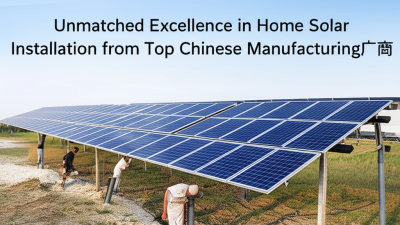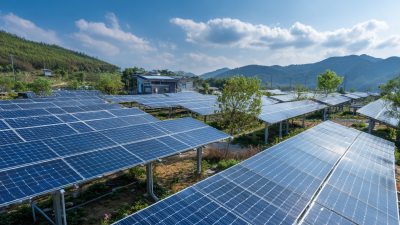The Future of Renewable Energy Unveiling the Power of Solar Collectors
The transition to renewable energy sources is accelerating globally, driven by the pressing need to mitigate climate change and reduce dependency on fossil fuels. Among the various technologies emerging in this sector, solar collectors stand out for their effectiveness in harnessing solar energy. According to the International Energy Agency (IEA), solar energy could potentially provide over 20% of global electricity by 2040, with solar thermal technologies, including solar collectors, playing a pivotal role in this expansion. As the cost of solar systems continues to decline—dropping by nearly 80% in the last decade—investments in solar collector technology are expected to grow substantially. A report from the Global Renewable Energy Agency (IRENA) estimates that solar thermal capacity could reach 600 GW by 2030, underscoring the immense potential of solar collectors in achieving a sustainable energy future. In this article, we will delve into the advancements in solar collector systems and their critical role in unleashing the power of renewable energy.

The Evolution of Solar Collector Technologies
The evolution of solar collector technologies has been pivotal in the transition toward sustainable energy solutions. Over the past few decades, advancements in materials and engineering have significantly enhanced the efficiency of solar thermal collectors. According to the International Renewable Energy Agency (IRENA), the global capacity of solar thermal collectors has grown to over 480 GWth in 2022, marking a substantial increase from previous years. This growth reflects innovations such as selective coating materials, which improve heat absorption, and the integration of smart technologies that optimize energy output based on weather conditions and usage patterns.
Furthermore, the emergence of concentrated solar power (CSP) systems has revolutionized the landscape of solar energy harvesting. CSP technology, which harnesses sunlight to generate high temperatures for electricity production, is projected to reach an installed capacity of more than 28 GW by 2025, as noted in a report by the U.S. Department of Energy. The latest developments in CSP involve hybrid systems that combine solar and fossil fuel energy sources, allowing for greater flexibility and reliability in power generation. These advancements not only promise to lower the cost of solar energy but also pave the way for wider adoption, contributing significantly to our global energy transition strategy.
The Future of Renewable Energy Unveiling the Power of Solar Collectors - The Evolution of Solar Collector Technologies
| Technology Type | Efficiency (%) | Cost (USD per Watt) | Lifespan (Years) | Applications |
|---|---|---|---|---|
| Thermal Solar Collectors | 60 | 0.07 | 20 | Heating Water |
| Photovoltaic Panels | 20 | 0.15 | 25 | Electricity Generation |
| Concentrated Solar Power | 25 | 0.10 | 30 | Utility-Scale Projects |
| Hybrid Solar Collectors | 45 | 0.12 | 20 | Combined Heat and Power |
| BIPV (Building-Integrated Photovoltaics) | 18 | 0.18 | 25 | Integrated in Buildings |
Key Advantages of Solar Collectors in Modern Energy Solutions
Solar collectors are emerging as a cornerstone in the transition towards renewable energy sources, offering several key advantages that make them indispensable in modern energy solutions. According to a report by the International Renewable Energy Agency (IRENA), the global installed capacity of solar thermal collectors reached approximately 487 gigawatts in 2022, highlighting a significant shift towards harnessing solar energy for heating and power generation. These systems not only reduce reliance on fossil fuels but also contribute to lowering greenhouse gas emissions, aligning with global climate goals.
One of the most significant benefits of solar collectors is their efficiency in converting sunlight into usable energy. Data from the U.S. Department of Energy indicates that solar thermal collectors can achieve efficiency ratings of up to 80%, particularly in well-designed systems. This contrasts sharply with traditional energy sources, where conversion efficiencies are typically lower. Furthermore, solar collectors provide an excellent return on investment through energy savings and incentives. Many regions offer rebates and tax credits, further enhancing the economic viability of solar technologies. By integrating solar collectors into modern energy infrastructures, both residential and commercial entities can capitalize on sustainable energy solutions that promise long-term benefits.
Comparative Analysis of Solar Collectors Versus Traditional Energy Sources
As the world increasingly shifts towards sustainable energy solutions, the comparative advantages of solar collectors over traditional energy sources are becoming more evident. According to a report by the International Renewable Energy Agency (IRENA), solar energy has the potential to meet up to 40% of the global energy demand by 2030. Solar collectors, which harness sunlight for heating and electricity generation, are not only more environmentally friendly but also more cost-effective in the long run. Unlike fossil fuels, which are susceptible to market fluctuations, solar energy costs have seen a consistent decline, with a 90% drop in photovoltaic costs over the past decade.
One of the most significant benefits of solar collectors is their efficiency in converting sunlight into usable energy. Advanced solar thermal collectors can achieve efficiencies of over 70%, compared to traditional power plants which often operate below 50%. This remarkable efficiency translates to higher energy output and lower greenhouse gas emissions. Furthermore, the versatility of solar collectors allows for integration in various applications, from residential heating to large-scale solar farms, making them an adaptable solution for a diverse energy landscape.
**Tip:** When considering solar energy options, evaluate the installation costs and potential savings. Many regions offer tax incentives and rebates that can further reduce initial investments. Additionally, consider the longevity and maintenance aspects of solar collectors to maximize your return on investment.
The Future of Renewable Energy: Comparative Analysis of Solar Collectors Versus Traditional Energy Sources
The Role of Innovations in Enhancing Solar Collector Efficiency
Innovations in solar collector technology are crucial for enhancing energy efficiency and boosting the adoption of renewable energy. Recent reports from the International Renewable Energy Agency (IRENA) highlight that improving the efficiency of solar collectors can increase energy output by as much as 30%. Advanced materials and designs, such as vacuum-sealed panels and nanotechnology, are being utilized to capture and convert sunlight more effectively. By minimizing thermal losses and optimizing absorber surfaces, these innovations are setting new benchmarks for performance in the industry.
Additionally, the integration of artificial intelligence (AI) in solar collector management systems is revolutionizing their operational efficiency. According to a study by the National Renewable Energy Laboratory (NREL), AI can predict weather patterns and adjust settings in real-time, leading to energy yield improvements of up to 20%. As countries strive towards meeting renewable energy targets, the ongoing advancements in solar collector technology will play a pivotal role in driving down costs and making solar energy a mainstream solution. Emphasizing these innovations is essential for stakeholders looking to harness the full potential of solar power in the coming decades.

Future Trends in Solar Collector Integration and Urban Planning
The integration of solar collectors into urban planning is quickly becoming a pivotal aspect of sustainable city development. As urban populations grow, the demand for energy-efficient systems, particularly in solar technology, is expected to rise considerably. According to a recent report from the International Renewable Energy Agency (IRENA), the global solar energy capacity is projected to increase eightfold by 2030 as cities integrate solar collectors into various infrastructure projects. This infusion of renewable energy solutions not only helps to mitigate greenhouse gas emissions but also enhances energy security for urban residents.

Cities are now looking to innovative designs that incorporate solar collectors into buildings, parks, and public spaces, harmonizing aesthetics with functionality. For instance, the Solar Urban Design Index (SUDI) indicates that cities implementing solar architectural elements can reduce their energy consumption by up to 60%. Furthermore, projects like the "Solar Roofs" initiative are incentivizing property developers to include solar technologies on new constructions, thereby seamlessly blending them into the urban landscape. As these trends pave the way for renewable energy's role in urban planning, the synergy between solar collectors and sustainable architecture will define the cities of the future.
Related Posts
-

Unmatched Excellence in Home Solar Installation from Top Chinese Manufacturing厂商
-

Advantages of Choosing the Best Solar Panels for Sustainable Energy Solutions
-

Uncompromising Quality in Solar Solutions: China’s Leading Manufacturing for Global Supply
-

Mastering Sunlight Solar Technology for Sustainable Energy Solutions
-

A Comprehensive Guide to Choosing the Best Residential Solar Panels for Your Home
-

How to Maximize Your Savings with Solar Electricity Solutions